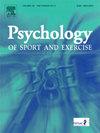Effect of different time intervals on the judgment of hitting timing among tennis athletes
IF 3.3
2区 心理学
Q2 HOSPITALITY, LEISURE, SPORT & TOURISM
引用次数: 0
Abstract
Background
Accurate time estimation is crucial for performance in dynamic sports environments, yet its underlying mechanisms remain unclear. In particular, the effects of periodic moving stimuli and different time intervals on time-to-contact (TTC) estimation have been overlooked. This study examines these effects in tennis athletes, providing insights into the cognitive mechanisms of temporal processing in dynamic sports contexts.
Methods
The cortical activity of 28 tennis athletes (17males; aged 23.11 ± 2.38 years) and 27 novices (20males; aged 22.19 ± 2.54 years) was measured using electroencephalography during a TTC task. Participants predicted when an invisible tennis ball would contact a target location under subsecond (0.667s) or suprasecond (1.333 s) intervals, following ball speed changes (0 %, +25 %, or −25 %).
Results
All participants showed better time estimation precision in the suprasecond interval. Athletes exhibited significantly lower variable errors (p = 0.015) and marginally lower absolute errors (p = 0.065), indicating greater consistency in time estimation. Electroencephalography revealed significantly higher CNV amplitudes in athletes (p < 0.001) and lower CNV in the subsecond interval (p < 0.001). Alpha band power was reduced in the subsecond interval (p < 0.001). Higher CNV amplitudes correlated with lower ABS (r = −0.127, p = 0.021), and lower CE was linked to greater alpha band power (r = −0.117, p = 0.033).
Conclusion
These findings indicate that beat-based timing in complex motion relies on higher-level cognitive resources for effective anticipation. Suprasecond intervals enhance better time estimation precision due to cognitive control, whereas subsecond intervals reduce precision. This suggests the formation of an internal model for time estimation. Exploring various time intervals further could inform interventions to improve timing performance in sports training.
不同时间间隔对网球运动员击球时机判断的影响
准确的时间估计对动态运动环境中的表现至关重要,但其潜在机制尚不清楚。特别是周期性运动刺激和不同时间间隔对接触时间(TTC)估计的影响一直被忽视。本研究考察了网球运动员的这些影响,为动态运动环境下时间加工的认知机制提供了见解。方法28例网球运动员(男17例;年龄23.11±2.38岁),新手27人(男性20人;年龄22.19±2.54岁),在TTC任务中使用脑电图测量。参与者预测一个看不见的网球何时会在亚秒(0.667秒)或超秒(1.333秒)的间隔内接触到目标位置,随着球的速度变化(0 %,+ 25%或- 25%)。结果所有被试在超秒区间内均表现出较好的时间估计精度。运动员的变量误差显著降低(p = 0.015),绝对误差略微降低(p = 0.065),表明时间估计的一致性更强。脑电图显示运动员的CNV振幅显著升高(p <;0.001),亚秒期CNV较低(p <;0.001)。α波段功率在亚秒间隔内降低(p <;0.001)。较高的CNV振幅与较低的ABS相关(r = - 0.127, p = 0.021),较低的CE与较高的α波段功率相关(r = - 0.117, p = 0.033)。结论复杂动作的节拍计时依赖于更高层次的认知资源来进行有效的预判。超秒间隔由于认知控制提高了时间估计精度,而亚秒间隔则降低了时间估计精度。这提示了时间估计的内部模型的形成。进一步探索不同的时间间隔可以为干预措施提供信息,以提高运动训练中的计时表现。
本文章由计算机程序翻译,如有差异,请以英文原文为准。
求助全文
约1分钟内获得全文
求助全文
来源期刊
CiteScore
6.40
自引率
5.90%
发文量
172
审稿时长
69 days
期刊介绍:
Psychology of Sport and Exercise is an international forum for scholarly reports in the psychology of sport and exercise, broadly defined. The journal is open to the use of diverse methodological approaches. Manuscripts that will be considered for publication will present results from high quality empirical research, systematic reviews, meta-analyses, commentaries concerning already published PSE papers or topics of general interest for PSE readers, protocol papers for trials, and reports of professional practice (which will need to demonstrate academic rigour and go beyond mere description). The CONSORT guidelines consort-statement need to be followed for protocol papers for trials; authors should present a flow diagramme and attach with their cover letter the CONSORT checklist. For meta-analysis, the PRISMA prisma-statement guidelines should be followed; authors should present a flow diagramme and attach with their cover letter the PRISMA checklist. For systematic reviews it is recommended that the PRISMA guidelines are followed, although it is not compulsory. Authors interested in submitting replications of published studies need to contact the Editors-in-Chief before they start their replication. We are not interested in manuscripts that aim to test the psychometric properties of an existing scale from English to another language, unless new validation methods are used which address previously unanswered research questions.

 求助内容:
求助内容: 应助结果提醒方式:
应助结果提醒方式:


